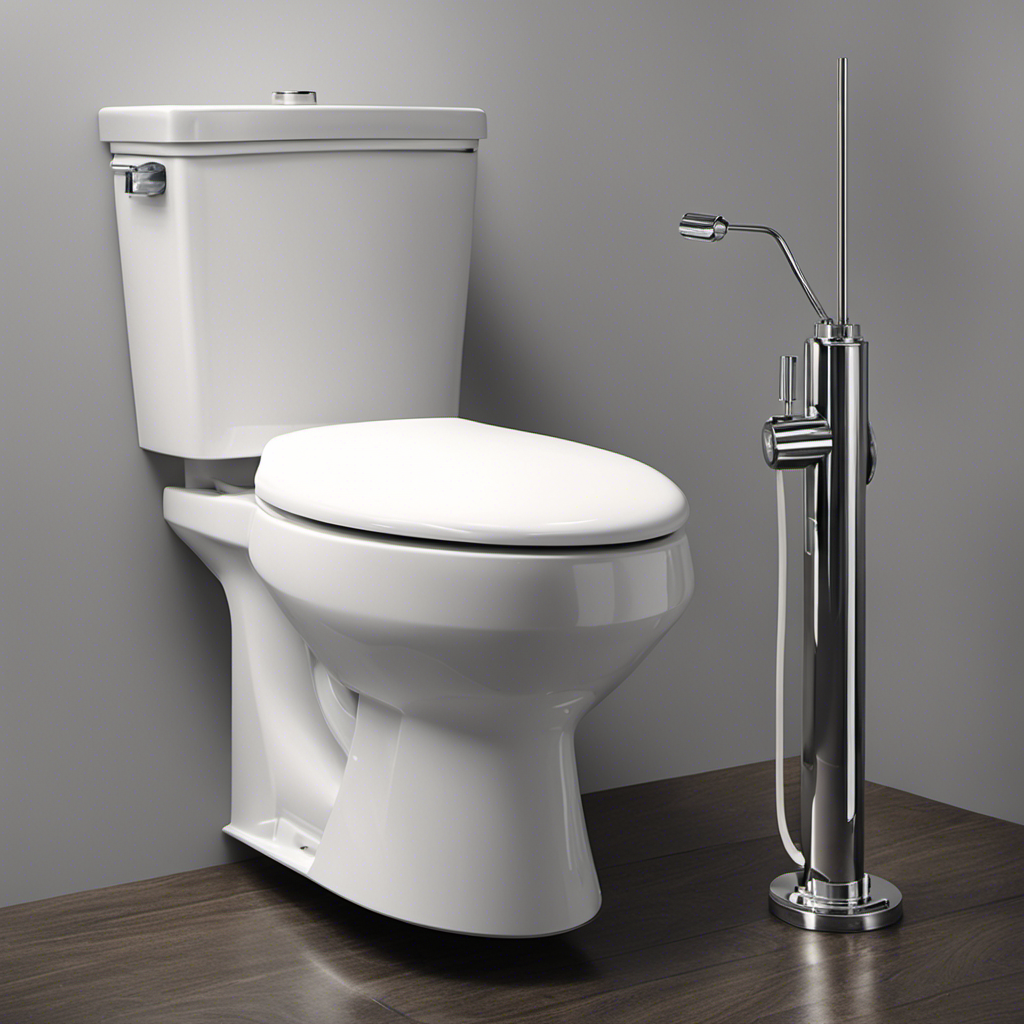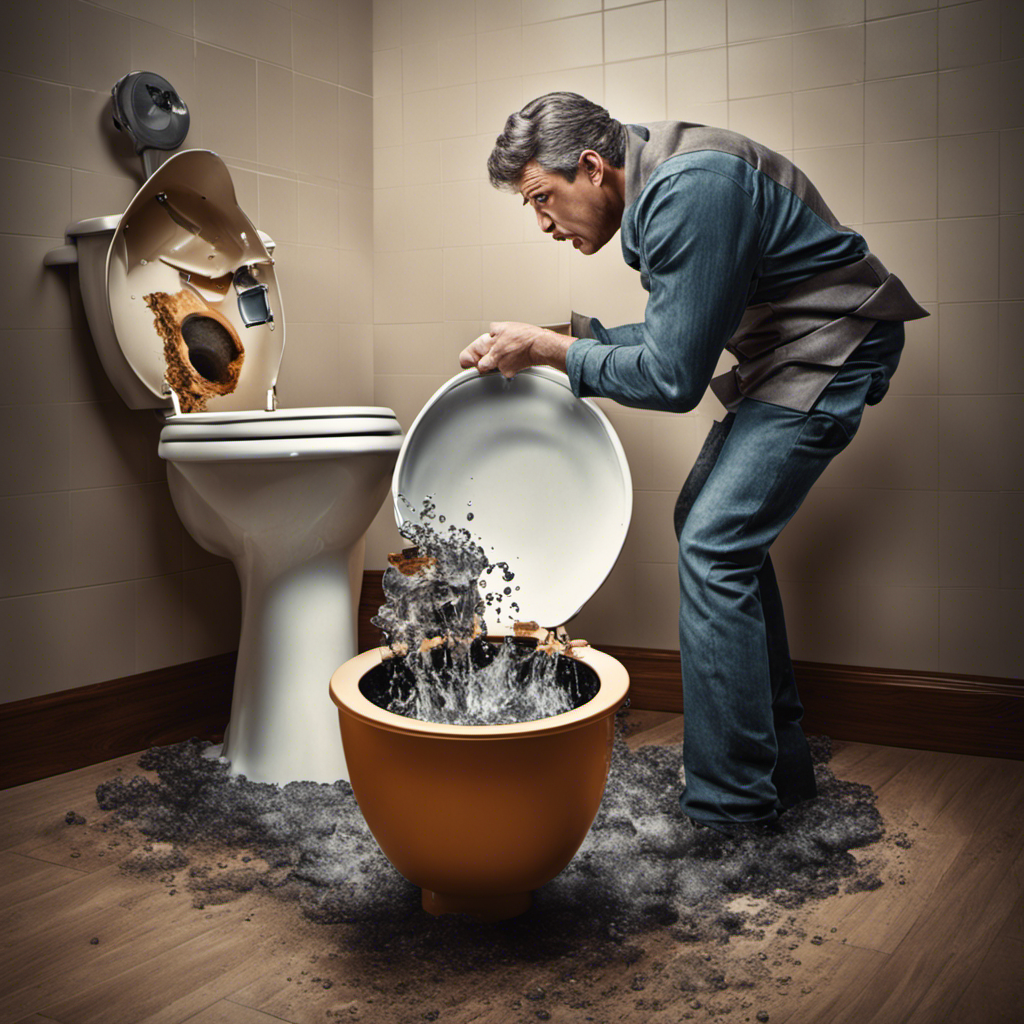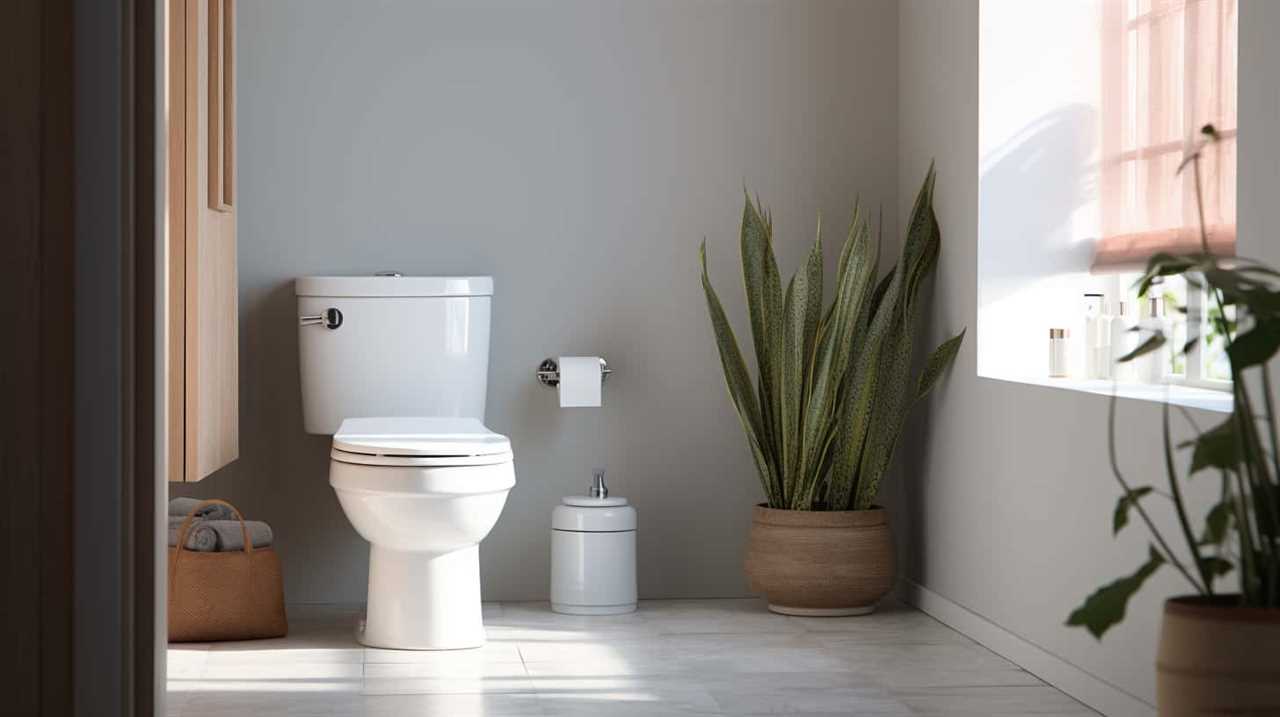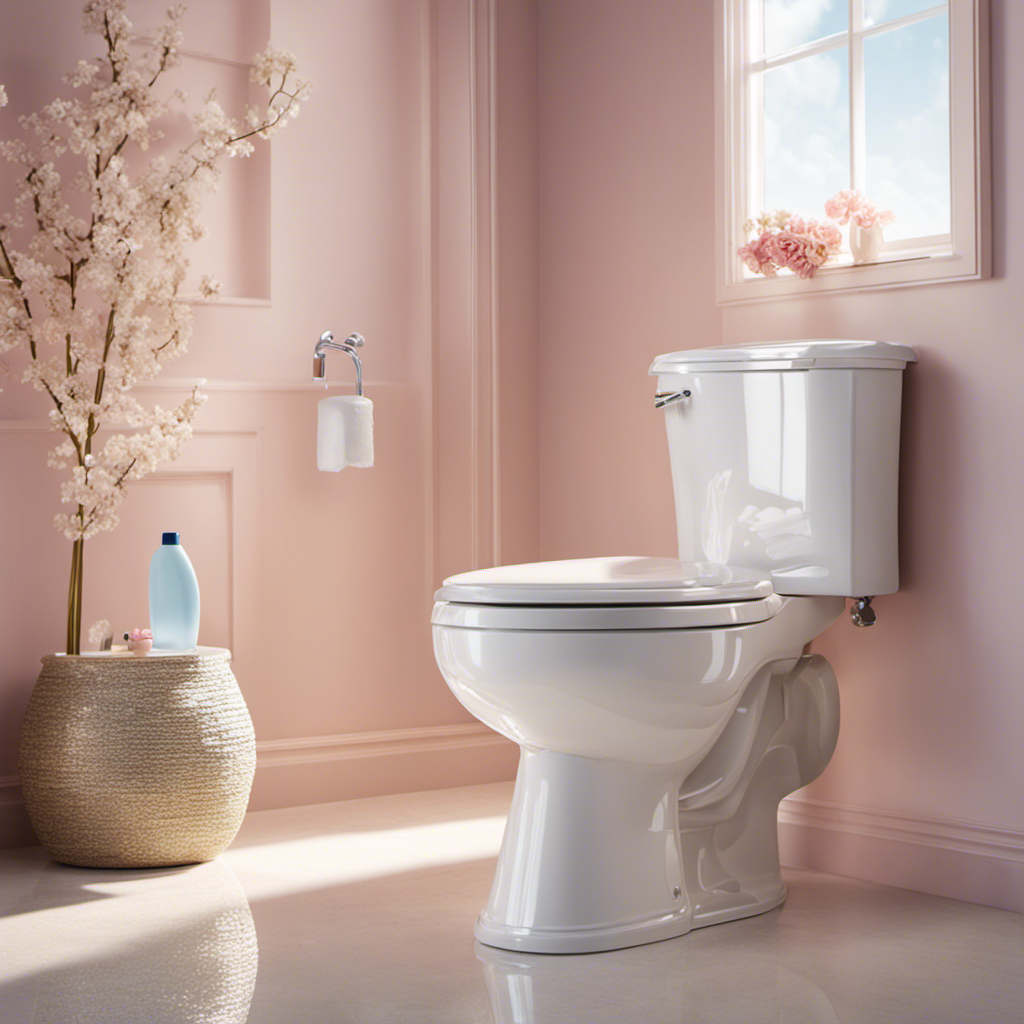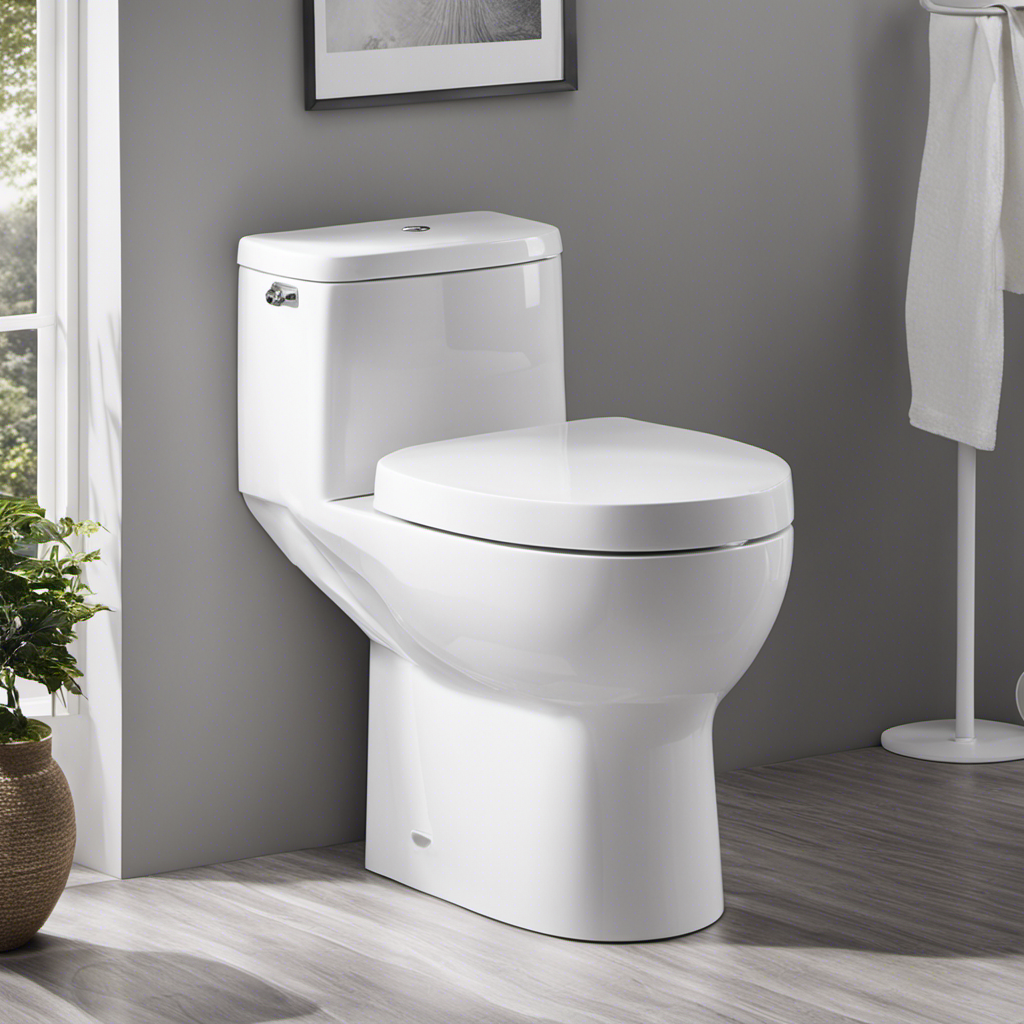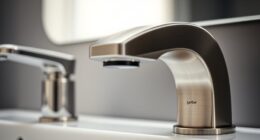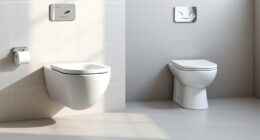I’ve always wondered why my toilet bowl never seems to have enough water. Did you know that the average toilet bowl should hold about 1.6 gallons of water?
It’s frustrating when you constantly have to flush multiple times just to get rid of waste. In this article, I’ll show you how to increase the water level in your toilet bowl so you can have a more efficient and effective flush every time.
No more wasting water or dealing with stubborn clogs!
Key Takeaways
- Low water levels in the toilet bowl could indicate a clogged toilet trap or a faulty fill valve.
- To evaluate and adjust the water supply, check the water pressure and inspect the water supply line for damage or restrictions.
- Adjusting the fill valve can increase water flow into the toilet bowl, improving overall performance and reducing clogging.
- Clearing and cleaning the toilet bowl jets is necessary to ensure a steady and powerful water flow, using a plunger to dislodge any clogs.
Understanding the Water Level in Your Toilet Bowl
To understand the water level in your toilet bowl, you can simply observe how much water is present. Evaluating toilet flush performance is important to ensure that your toilet is functioning properly. If you notice that the water level in your toilet bowl is consistently low, it could indicate a problem.
Troubleshooting low water levels can help identify the underlying issue. One possible cause could be a clogged toilet trap, preventing sufficient water from entering the bowl during a flush. Another potential reason could be a faulty fill valve, which regulates the water level in the tank.
Evaluating the Water Supply to Your Toilet
Check if there’s enough water flowing into your toilet tank. One way to evaluate the water supply to your toilet is by checking the water pressure.
Start by turning on a nearby faucet and observe the flow. If the water pressure is low, it could affect the amount of water that fills your toilet bowl.
Another thing to check is the water supply line. Make sure it is properly connected and not kinked or blocked in any way. A damaged or restricted supply line can limit the water flow to your toilet.
If you find any issues with the water pressure or supply line, it may be necessary to call a professional plumber for further assistance. Adjusting the fill valve to increase water flow can help address this problem.
Adjusting the Fill Valve to Increase Water Flow
To maximize the water level in your toilet bowl, one key point to consider is adjusting the fill valve for optimal flow.
By making adjustments to the fill valve, you can increase the water flow into the toilet bowl, ensuring that it reaches the desired level.
Increasing the water flow can help improve the overall performance of your toilet and prevent any issues related to low water levels.
Maximize Toilet Water Level
You can increase the water level in your toilet bowl by adjusting the float in the tank. This simple adjustment can make a big difference in your toilet’s performance.
Here are a few reasons why you might want to increase the water level in your toilet:
-
Enhanced flushing power: A higher water level allows for a stronger flush, ensuring that waste is properly cleared from the bowl.
-
Reduced clogging: With more water in the bowl, there is less chance of clogs occurring, preventing any potential plumbing headaches.
-
Improved cleanliness: A higher water level helps to keep the bowl cleaner by providing more water to rinse away residue and prevent stains.
Adjust Valve for Flow
Adjusting the valve will regulate the flow of water in the tank, improving the overall performance of your toilet.
To increase the flow of water in the tank, locate the water supply valve, usually located on the wall behind the toilet. Turn the valve counterclockwise to open it fully, allowing more water to enter the tank.
This adjustment will result in a stronger flush and a higher water level in the bowl. However, it is important to note that increasing the flow too much may lead to water waste or even overflowing.
It is recommended to make small adjustments and test the toilet’s performance after each adjustment. By properly adjusting the valve, you can optimize the flow of water and ensure an efficient and effective flush.
Increase Water Flow
Increasing the flow of water in the tank can be achieved by opening the water supply valve fully, resulting in a stronger flush and higher water level in the tank. This simple adjustment can significantly improve the performance of your toilet and ensure a more efficient and effective flush.
However, if you’re looking for a more long-term solution to increase water pressure and save water, you might consider installing a dual flush system. This innovative system allows you to choose between a full flush and a half flush, depending on your needs. By using less water for liquid waste, you can reduce your water consumption and contribute to water conservation efforts.
Additionally, installing a dual flush system can also help increase the water pressure in your toilet, providing a more powerful and thorough flush every time. So not only will you be saving water, but you’ll also be enjoying a better flushing experience.
Checking and Adjusting the Float Ball or Cup
To make sure your toilet bowl has enough water, check and adjust the float ball or cup.
Start by lifting the lid of the toilet tank. Locate the float ball or cup, which is typically attached to the fill valve. Check for any leaks or damage to the float mechanism. If you notice any leaks, it may be necessary to replace the float mechanism.
To adjust the water level, simply bend the float arm down to lower the water level or up to increase it. Make sure the water level is about 1 inch below the top of the overflow tube.
Once adjusted, flush the toilet to see if the water level is sufficient. Repeat the process if necessary until you achieve the desired water level in your toilet bowl.
Clearing and Cleaning the Toilet Bowl Jets
When it comes to maintaining a properly functioning toilet, it’s important to address issues such as unclogging toilet bowl jets, improving water flow, and removing mineral deposits.
Over time, these jets can become clogged with debris, causing water to flow inefficiently and potentially leading to blockages. By cleaning the jets and removing any mineral deposits, you can ensure a steady and powerful water flow, preventing future problems and keeping your toilet working smoothly.
Unclogging Toilet Bowl Jets
You can start by checking if the toilet bowl jets are clogged. If you notice that the water isn’t flowing properly, it’s possible that there is a blockage in the pipes.
To unclog the toilet bowl jets, follow these steps:
- First, put on rubber gloves to protect your hands from any potential mess.
- Next, grab a plunger and place it firmly over the drain hole in the toilet bowl.
- Make sure there is enough water in the bowl to cover the plunger’s cup.
- Begin plunging up and down vigorously, creating suction to dislodge the clog.
- Repeat this motion several times until you feel the clog loosening.
- Once you’ve successfully unclogged the toilet bowl jets, flush the toilet to ensure proper water flow.
Improving Water Flow
If the water isn’t flowing properly, it may be helpful to check for any blockages in the pipes.
Improving water pressure and increasing flush effectiveness can be achieved by taking a few simple steps.
First, make sure the water supply valve is fully open. If it is partially closed, it can restrict the flow of water into the toilet bowl.
Next, inspect the fill valve and float mechanism. If they are faulty or worn out, they may not be allowing enough water into the toilet bowl. Consider replacing them if needed.
Additionally, check the diameter of the supply line. A larger diameter can increase water flow and improve pressure.
Lastly, clean the rim jets and siphon jets regularly to remove any mineral deposits or debris that may be obstructing the flow of water.
Removing Mineral Deposits
To remove mineral deposits in the toilet, start by pouring a mixture of vinegar and baking soda into the bowl. The acidic properties of vinegar help break down the stubborn stains, while the baking soda acts as a gentle abrasive to scrub them away.
Here are three reasons why using this vinegar solution is beneficial:
-
Environmentally friendly: Using vinegar as a cleaning agent reduces the need for harsh chemicals that can harm the environment.
-
Cost-effective: Vinegar is an affordable and readily available household item, making it a cost-effective solution for removing mineral deposits.
-
Safe for pipes: Unlike some commercial cleaning products, vinegar is non-corrosive and won’t damage your plumbing system.
Troubleshooting and Fixing Clogged or Partially Blocked Toilet Jets
Check if the toilet jets are clogged or partially blocked by using a plunger. This is an important step in troubleshooting toilet flush and fixing toilet bowl overflow.
To begin, ensure that the plunger is submerged in water and create a tight seal around the toilet drain. Push and pull the plunger vigorously, using a pumping motion, to generate pressure and dislodge any obstruction in the jets. Repeat this process several times if necessary.
If the toilet jets remain clogged or partially blocked after attempting to plunge, it may be time to seek professional help for persistent water level issues. A plumbing expert will have the necessary tools and expertise to diagnose and resolve the problem effectively.
Seeking Professional Help for Persistent Water Level Issues
When experiencing persistent water level issues, it’s time for you to consider seeking professional help.
Here are a few reasons why seeking plumbing services can be beneficial:
-
Peace of mind: Hiring a professional plumber ensures that the issue will be accurately diagnosed and fixed, giving you peace of mind.
-
Expertise and experience: Plumbers have the necessary knowledge and experience to identify the root cause of the problem and provide a long-lasting solution.
-
Time-saving: Instead of spending hours researching DIY toilet bowl maintenance techniques and potentially making the problem worse, a professional can quickly resolve the issue.
Conclusion
In conclusion, by understanding the water level in your toilet bowl and evaluating the water supply, you can adjust the fill valve to increase water flow.
Additionally, checking and adjusting the float ball or cup, as well as clearing and cleaning the toilet bowl jets, can help improve the water level.
However, if persistent issues arise, seeking professional help is recommended.
Just as a skilled captain navigates rough waters, a knowledgeable plumber can steer your toilet’s water level to smooth sailing.
